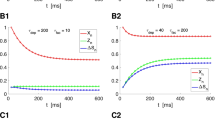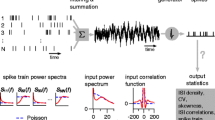Abstract
It is known (e.g., Perkel et al., 1964) that when a pacemaker neuron elicits IPSP's in another, there are domains called “paradoxical segments” where in the steady-state i) faster inhibitory discharges determine faster inhibited ones, and ii) pre- and postsynaptic spikes are “locked” in an invariant forward-and-backward positioning in time, spikes alternating in the ratios 1:1 (1 pere for 1 postsynaptic), 1:2, 2:1..., that are also the slopes of the synaptic rate-transformation. The present project examined the matter further in the inhibitory synapse upon the crayfish tonic stretch receptor neuron, confirming the above. In addition it showed that locking and alternation existed also in the segments interposed between the 1:2, 1:1 and 2:1 paradoxical segments, even though they were not as marked and apparent, and that when tests were close to each other their order became influential and hysteresis-like phenomena appeared. The main finding was that paradoxical rate-relations, locking and alternation persisted when the presynaptic train was irregularized up to interval coefficients of variation of around 0.20 (Figs. 2–5). Therefore, both phenomena may not simply be laboratory curiosities, but also have a role in natural operation where probably a substantial population of neurons exhibits that kind of irregularity. As presynaptic irregularity increased, the paradoxical segment slopes and widths decreased and locking and alternation became less clear-cut. With CV's of about 0.20, only a relatively narrow 1:1 paradoxical segment with about O slope and little locking and alternation remained (Figs. 2b, 3g, 4right, 5third row). With larger CV's, the rate relation decreased monotonically and there was no locking nor alternation (Figs. 2e, 3h, 5bottom row). The postsynaptic discharge was more regular and had fewer changes in the number of presynaptic spikes per post-synaptic interval within paradoxical segments (particularly in their centers) than in segments interposed between them (left vs. right-hand columns in Figs. 5, 6; Fig. 7): the contrast, remarkable for regular stimuli, attenuated as variability increased. The following conclusions are relevant to coding of spike trains across a synapse with IPSP's. i) With fairly regular discharges, the same postsynaptic rate may result from several presynaptic ones (e.g., may result from rates in the 1:1 and 2:1 paradoxical segments and in the interposed one, Fig.2): in some cases but not others, the precise presynaptic rate can be identified on the basis of postsynaptic CV's, interval histograms and cycle slips. ii) A small rate change in a regular presynaptic discharge will have very different postsynaptic consequences depending on where it happens: if across a paradoxical-interposed boundary, for instance, it will cause remarkable rate, pattern and correlation changes. iii) The trans-synaptic mapping of variability involves an increase for the more regular presynaptic discharges and a decrease for the more irregular ones. iv) The postsynaptic discharge was slower with IPSP's than without in most cases; however, when the control discharge was weak or absent, IPSP's accelerated it. Results are relevant also to the operation of periodically performing systems that involve neuronal correlates, indicating that it is necessary in every case to ask whether zigzag relations and locking occur. The “delay function” plots the arrival time of an IPSP (or IPSP burst) relative to the last postsynaptic spike, i.e., the “phase” (Φ in Fig. 1b), against the interval lengthening produced, i.e., the “delay” (δ). In all cases, most points clustered around a straight line (Fig. 8), whose slope and ordinate intercept were in the 0.43–0.87 and the 0.02–0.52 ranges, respectively, for single IPSP's. The slope reflects how the IPSP effectiveness depends on when it arrives in the cycle; the intercept reflects the IPSP effectiveness. Large phases often showed “aberrant” points whose ordinates were either large (and having special formal implications), or very small (perhaps reflecting conduction and synaptic delays), or clustered around a second straight segment with a large negative slope (when spontaneous rates were low) (Fig. 8c). Delay functions for widely separated pairs of IPSP's could be multi-valued, points clustering around 2 or 3 parallel straight lines. A mathematical model of pacemaker inhibitory synaptic interactions (Segundo, 1979) agreed with this embodiment insofar as some postulated properties are concerned (e.g., regular discharge, interval lengthening by IPSP's, linear delay functions with slopes around 0.7) and as to the main aspects of the preparation's behavior (i.e., zigzag rate relations and locking), but not in terms of some aspects of the postulates (e.g., interval variability, rebound) or behavior (e.g., segment boundaries, jitter in the locking, and hysteresis). The model was judged to be on the balance satisfactorily realistic.
Similar content being viewed by others
References
Ayers, J.L., Selverston, A.I.: Monosynaptic entrainment of an endogenous pacemaker network: a cellular mechanism for von Holst's magnet effect. J. Comp. Physiol.129, 5–17 (1979)
Best, E.N.: Null space in the Hodkin-Huxley equations. A critical test. Biophys. J.27, 87–104 (1979)
Brillinger, D.R., Bryant, H.L., Segundo, J.P.: Identification of synaptic interactions. Biol. Cybern.22, 213–228 (1976)
Bryant, H.L., Ruiz Marcos, A.R., Segundo, J.P.: Correlations of neuronal spike discharges produced by monosynaptic connections and by common inputs. J. Neurophysiol.36, 205–225 (1973)
Burkhardt, D.: Die Sinnesorgane des Skeletmuskels und die nervöse Steuerung des Muskeltätigkeit. Ergeb. Biol.20, 27–66 (1958)
Cooley, J., Dodge, F., Cohen, H.: Digital computer solutions for excitable membrane models. J. Cell. Comp. Physiol.66, 99–110 (1965)
Cox, D.R., Lewis, P.A.W.: The statistical analysis of series of events. London: Methuen 1966
Craelius, W.: The distribution of GABA sensitivity on crayfish muscle receptor organs. J. Physiol.263, 405–415 (1976)
Eckert, R.O.: Reflex relationships of the abdominal stretch receptors of the crayfish. I. Feedback inhibition of the receptors. J. Cell. Comp. Physiol.57, 149–162 (1961)
Eyzaguirre, C., Kuffler, S.: Processes of excitation in the dendrites and in the soma of single isolated sensory nerve cells of the lobster and crayfish. J. Gen. Physiol.39, 87–119 (1955)
Feitz, A.: Competitive interaction of β-guanidinopropionic acid and ψ-amino butyric acid on the muscle fiber of crayfish. J. Physiol.216, 391–401 (1971)
Firth, D.R.: Interspike interval fluctuation in the crayfish stretch receptor. Biophys. J.6, 201–215 (1966)
Florey, E., Florey, E.: Microanatomy of the abdominal stretch receptors of the crayfish (Astacus fluviatilis). J. Gen. Physiol.39, 69–85 (1955)
Gibbons, J.D.: Nonparametric statistical inference. New York: McGraw-Hill 1971
Glass, L., Graves, C., Petrillo, G.A., Mackey, M.C.: Unstable dynamics of a periodically driven oscillator in the presence of noise. J. Theor. Biol. (in press)
Glass, L., Mackey, M.C.: A simple model for phase-locking of biological oscillators. J. Math. Biol.7, 339–352 (1979)
Grundfest, H.: On the how and why of synapses. In: Synaptic transmission and neuronal interaction, pp. 1–21. Bennett, M.V.L. (ed.). New York: Raven Press 1974
Grüsser, O.J., Thiele, B.: Reaktionen primärer und sekundärer Muskelspindeln Afferenzen auf sinusförmige mechanische Reizung. Pfluegers Arch.300, 161–184 (1968)
Hartline, D.K.: Simulation of phase-dependent pattern changes to perturbations of regular firing in crayfish stretch receptor. Brain Res.110, 245–257 (1976)
Hartline, D.K., Gassie, D.V.: Pattern generation in lobster (Panulirus) stomatogastric ganglion. I. Pyloric neuron kinetics and synaptic interactions. Biol. Cybern.33, 209–222 (1979)
Hoel, P.G., Port, S.C., Stone, C.J.: Introduction to probability theory. Boston: Houghton Mifflin 1971
Kawato, M.: What do phase-response curves tell us about inner structure of biological oscillators? (submitted to J. Math. Biol. 1980)
Kawato, M., Suzuki, R.: Biological oscillators can be stopped —topological study of a phase response curve. Biol. Cybern.30, 241–248 (1978)
Kohn, A.F.: Influence of presynaptic irregularity on the inhibition of a pacemaker in crayfish and neuromine. Thesis, University of California at Los Angeles 1980
Kuffler, S.W., Eyzaguirre, C.: Synaptic inhibition in an isolated nerve cell. J. Gen. Physiol.39, 155–184 (1955)
Levy, M.N., Martin, P.J., Iano, T., Zieske, H.: Paradoxical effects of vagus nerve stimulation on heart rate in dogs. Circ. Res.25, 303–314 (1969)
Lindsey, W.C.: Synchronization systems in communications and control. New Jersey: Prentice-Hall 1972
Matthysse, H.: Hysteresis and history in the GABA system. In: GABA in nervous system function, pp. 337–346. Roberts, E., Chase, T.N., Tower, D.B. (eds.). New York: Raven Press 1976
Maynard, D.M.: Cardiac inhibition in decapod crustacea. In: Nervous inhibition, pp. 144–178. Florey, E. (ed.). New York: Pergamon Press 1961
Moore, G.P., Perkel, D.H., Segundo, J.P.: Stability patterns in interneuronal pacemaker regulation. In: Proc. San Diego Symp. Biomed. Eng., pp. 184–193. Paull, A. (ed.). La Jolla, 1963
Nja, A., Walløe, L.: Reflex inhibition of the slowly adapting stretch receptors in the intact abdomen of the crayfish. Acta Physiol. Scand.94, 177–183 (1975)
Perkel, D.H., Schulman, J.H., Bullock, T.H., Moore, G.P., Segundo, J.P.: Pacemaker neurons: effects of regularly spaced synaptic input. Science145, 61–63 (1964)
Pinsker, H.M.: Aplysia bursting neurons as endogenous oscillators. I. Phase response curves for pulsed inhibitory synaptic input. J. Neurophysiol.40, 527–543 (1977a)
Pinsker, H.H.: Aplysia bursting neurons as endogenous oscillators. II. Synchronization and entrainment by pulsed inhibitory synaptic input. J. Neurophysiol.40, 544–556 (1977b)
Rescigno, A.: On phase-locking of pulse encoders. Bull. Math. Biol.40, 807–821 (1978)
Schulman, J.H.: Information transfer across an inhibitor to pacemaker synapse at the crayfish stretch receptor. Thesis, University of California at Los Angeles 1969
Segers, M., Lequime, J., Denolin, H.: Synchronization of auricular and ventricular beats during complete heart block. Am. Heart. J.33, 685–691 (1947)
Segundo, J.P., Pacemaker synaptic interactions: modelled locking and paradoxical features. Biol. Cybern.35, 55–62 (1979)
Segundo, J.P., Kohn, A.F.: A model of excitatory synaptic interactions between pacemakers. Its reality, its generality and the principles involved. Biol. Cybern. (in press)
Segundo, J.P., Perkel, D.H.: The nerve cell as an analyzer of spike trains. In: The interneuron. Ucla forum in medical sciences. No. 11, pp. 349–389. Brazier, M.A.B. (ed.). Los Angeles: University California Press 1969
Segundo, J.P., Perkel, D.H., Wyman, H., Hegstad, H., Moore, G.P.: Input-output relations in computer-simulated nerve cells. Kybernetik4, 157–171 (1968)
Segundo, J.P., Tolkunov, B.F., Wolfe, G.E.: Relation between trains of action potentials across an inhibitory synapse. Influence of presynaptic irregularity. Biol. Cybern.24, 169–179 (1976)
Shimahara, T., Tauc, L.: Heterosynaptic facilitation in the giant cell of aplysia. J. Physiol. (Lond.)247, 321–341 (1975)
Skvaril, J., Radil-Weiss, T., Bohdanecky, Z., Syka, J.: Spontaneous discharge patterns of mesencephalic neurons: interval histogram and mean interval relationship. Kybernetik9, 11–15 (1971)
Sokolove, P.G., Cooke, I.M.: Inhibition of impulse activity in a sensory neuron by an electrogenic pump. J. Gen. Physiol.57, 125–163 (1971)
Spear, J.F., Kronhaus, K.D., Moore, E.N., Kline, R.P.: The effect of brief vagal stimulation on the isolated rabbit sinus node. Circ. Res.44, 75–88 (1979)
Stein, P.G.: Neural control of interappendage phase during locomotion. Am. Zool.14, 1003–1016 (1974)
Swigert, C.J.: A mode control of a neuron's axon and dendrites. Int. J. Neurosci.1, 51–65 (1970)
Takeuchi, A., Takeuchi, N.: Anion permeability of the inhibitory postsynaptic membrane of the crayfish stretch receptor. J. Physiol.191, 575–590 (1967)
Teorell, T.: A biophysical analysis of mechano-electrical transduction. In: Handbook of sensory physiology, Vol. 1, pp. 291–339. Loewenstein, W.R. (ed.). Berlin, Heidelberg, New York: Springer 1971
Vibert, J.F., Caille, D., Segundo, J.P.: Respiratory oscillator entrainment by periodic vagal afferences: an experimental test of a model. Biol. Cybern. (in press)
Winfree, A.T.: The geometry of biological time. Berlin, Heidelberg, New York: Springer 1980
Author information
Authors and Affiliations
Additional information
Supported by funds from the Brain Research Institute, Ucla
Supported by FAPESP (Sao Paulo, Brazil)
Rights and permissions
About this article
Cite this article
Kohn, A.F., Freitas da Rocha, A. & Segundo, J.P. Presynaptic irregularity and pacemaker inhibition. Biol. Cybern. 41, 5–18 (1981). https://doi.org/10.1007/BF01836123
Received:
Issue Date:
DOI: https://doi.org/10.1007/BF01836123




